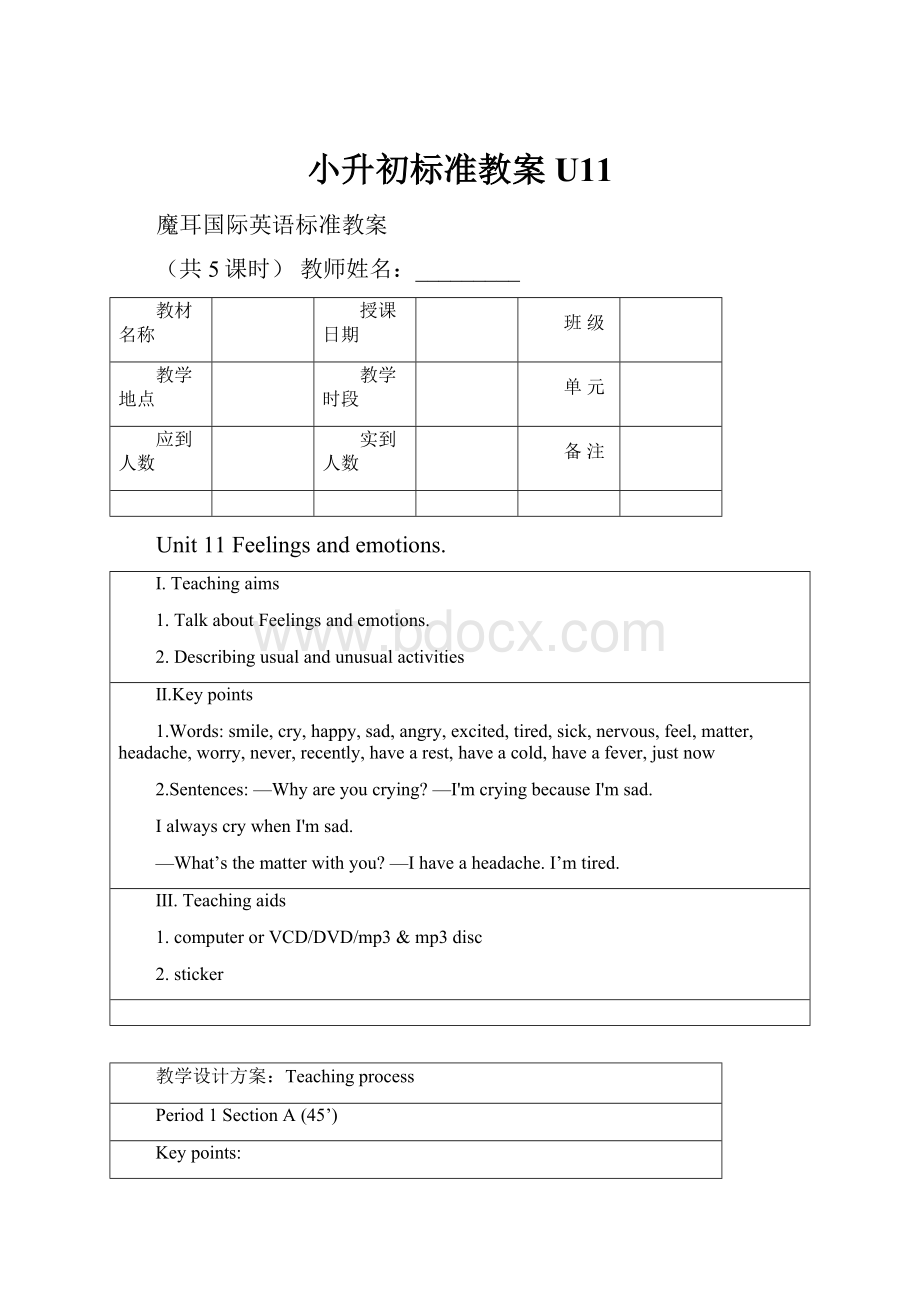小升初标准教案U11.docx
《小升初标准教案U11.docx》由会员分享,可在线阅读,更多相关《小升初标准教案U11.docx(18页珍藏版)》请在冰豆网上搜索。

小升初标准教案U11
魔耳国际英语标准教案
(共5课时)教师姓名:
_________
教材名称
授课日期
班级
教学地点
教学时段
单元
应到人数
实到人数
备注
Unit11Feelingsandemotions.
Ⅰ.Teachingaims
1.TalkaboutFeelingsandemotions.
2.Describingusualandunusualactivities
Ⅱ.Keypoints
1.Words:
smile,cry,happy,sad,angry,excited,tired,sick,nervous,feel,matter,headache,worry,never,recently,havearest,haveacold,haveafever,justnow
2.Sentences:
—Whyareyoucrying?
—I'mcryingbecauseI'msad.
IalwayscrywhenI'msad.
—What’sthematterwithyou?
—Ihaveaheadache.I’mtired.
Ⅲ.Teachingaids
1.computerorVCD/DVD/mp3&mp3disc
2.sticker
教学设计方案:
Teachingprocess
Period1SectionA(45’)
Keypoints:
1.smile,cry,happy,sad,angry,excited,tired,sick,nervous,feel,because,matter
2.—singasong,haveagoodtime,haveaheadache,haveagoodrest,feelbetter.
3.—Whyareyoucrying?
—I'mcryingbecauseI'msad.
4.—Whatdoyoudoifyouarehappy?
—IsingasongwhenI’mhappy.
5.—Howwasyourholiday?
—Itwasgreat.
6.—Howdoyoufeelnow?
—I’mexcited.
7.—What’sthematterwithyou?
—Ihaveaheadache.
Teachingprocedures:
Let’slearn
(22’)
Step1:
Lead-in&presentation(15’)
T:
Hi!
Class!
OpenyourbooksandlookatthepicturesonP77.Whatarethese?
Right,theyarepicturesofdifferentkindsoffeelingsandemotions.DoyouknowhowtospeaktheminEnglish?
Nowletmetellyou!
MakeSsreadthewordsafterT.Thenplayagame.
Step2:
PlayGame:
ProgressiveReplacement(7’)
T:
Isingasong.
S1:
Isingasong.
T:
Often.
S1:
Ioftensingasong.
T:
Atsix.
S2:
Ioftensingasongatsix.
T:
He.
S3:
Heoftensingsasongatsix.
T:
Does.
S4:
Doesheoftensingasongatsix?
T:
How.
S5:
Howdoesheoftensingasongatsix?
T:
Iamsingingasong.
…
游戏指导:
教师提供一个句子,先读一遍,接着教师每次给一个新词,要求一个学生用所给新词插入句中,并将该句复述一遍。
通过游戏连续替换(ProgressiveReplacement)
练习时态及句型转换
Let’slistenandsay(10’)
Step1:
listenandfollow.(5’)
T:
Let’slistentotheMP3,andthenpracticetheconversationsinpairs.
先让学生听对话录音,教师示范,学生跟读,等学生熟练对话内容后再结对练习
Step2:
MakeSsactouttheconversation.(5’)
T:
NowI’llchoosesomeofyoutoactouttheconversations.
T:
Youshouldtalkasthetwopeoplesaidintheconversations.
此部分是为了练习学生的语言应用能力。
Let’sact(13’)
Step1:
MakeSsreadtheconversation.(5’)
T:
LookattheconversationonP78,twopeoplearetalkingaboutfeelings.Nowlet’spracticetheconversation,andthenmakeourownconversationsastheydo.
教师示范,学生跟读,等学生熟练对话内容后再结对练习
Step2:
MakeSsworkingroupstoactouttheconversationandtrytomakenewconversations.(8’)
T:
NowI’llchoosesomeofyoutoactouttheconversationonP78.
ANSWER:
variousversions
学生分组结对练习后,上台表演对话,可以表演自己编的新对话。
板书格局
竞争
机制
重要语法及语言点
(整堂保留)
Unit11Feelingsandemotions.
重要单词
(整堂保留)
—Whyareyoucrying?
—I'mcryingbecauseI'msad.
—Whatdoyoudoifyouarehappy?
—IsingasongwhenI’mhappy.
—Howwasyourholiday?
—Itwasgreat.
—Howdoyoufeelnow?
—I’mexcited.
—What’sthematterwithyou?
—Ihaveaheadache.
机动板块,用于做游戏画图或表格,或临时要写的文字。
教学设计方案:
Teachingprocess
Period2SectionB&C(45’)
Keypoints:
1.feel,matter,worry,hot,medicine,hope,surprise,never,recently
2.havearest,haveacold,haveafever,afew,justnow,sayhelloto,stayinbed
3.ThisisSamspeaking.
4.Iamsorrytohearthat.
5.Ihopeyouwillgetbettersoon.
6.Thankyouagainandsayhellotoallmyfriends.
Teachingprocedures:
Let’sread
(30’)
Step1:
Lead-in&presentation(25’)
T:
Nowreadthepassage,underlinethewordsandphrasesyoudon’tknow.
TeachSsthekeywordsandsentences,explainthearticletoSs.ThenmakeSsanswerthequestionsbelow.
answers:
(1)Hehasafever.
(2)Sheisplayingthepiano.
(3)Yes,sheis.
(4)Theyareplayinggames.
(5)Theywillgivehimasurprise.
MakeSsreadthearticlealoud.
此部分要注意以下重点:
1.重点单词、短语及句型。
2.要求背诵。
Step2:
PlayaGame:
Telephone(5’)
S1:
(Dialing)2356,(Class2,Group3,Team5,Row6)
S2:
Hello,thisisMike.
S1:
Isthatyou,Mike?
ThisisSam.Howareyou?
S2:
Fine,thankyou.Andyou?
S1:
Fine,too.Goodbye.
S2:
Goodbye.
(S2givesaquickresponseandit’shisturntodial.)
游戏规则:
要求每个学生写出一个四位数的电话号码,第一位数指班级,第二位指组别,第三位指直行,第四位指横列,所有这些数字都写在一张纸上。
第一个学生说出一个号码,手拿号码的学生马上站起来接电话。
电话号码说错的和回答慢的算犯规。
Let’swrite
(10’)
Readandwrite(10’)
T:
Nowpleasereadthepassage,andwritesomethinglikeit.Usingthesamestructuresasthegivenpassage.
此部分要注意帮助学生找到重点句型,让他们分清楚哪些是关键结构,哪些是可替换的内容。
SectionC
(5’)
Let’slistenandfill(5’)
T:
Now,let’slistentotheMP3andfillintheblanks.
Answers:
(1)arewatching,excited
(2)isgoingtobuy,happy(3)isgoing,sad
(4)doesGinafeel,tired(5)iscrying,angry
此部分是对不同时态和表示感觉的形容词的训练。
让学生注意区分不同时态。
板书格局
竞争
机制
重要短语
及句型
(整堂保留)
Unit11Feelingsandemotions.
重要单词
(整堂保留)
本课知识点讲解
机动板块,用于做游戏画图或表格,或临时要写的文字。
教学设计方案:
Teachingprocess
Period3SectionC&D(45’)
Keypoints:
1.一般现在时,现在进行时,一般将来时和一般过去时的时态对比
2.表示情绪和感觉的词汇。
3.always,never,sometimes,often,usually,now,justnow…
Teachingprocedures:
SectionC
(19’)
Step1:
Greeting(2’)
T:
Hello!
Class./Howareyou?
/Goodmorning!
/What’stheweatherliketoday?
/It’sasunnydaytoday!
/Areyouhappytoday,myclass?
开课前的问候是为了充分调动学生学习的兴趣和热情,并尽可能长时间地吸引他们的注意力,这是一堂课能否顺利进行的关键,所以老师们一定要充满热情,并表现出对每个孩子的关注和关心。
Step2:
Roll-call&Warmup(2’)
Roll-callT:
callnamesSs:
Here!
/Nothere!
Step3:
Let’smatch(5’).
T:
Choosesentencesfromtheboxtocompletetheconversation.
Answers:
BDACE
MakeSsreadthedialoguealoud.
完成题目后让学生读对话,体会对话中时态的变化。
Step4:
Let’slistenandact(10’)
T:
Nowlet’slistentotheMP3,andthenactouttheconversationinpairs.
先让学生听对话录音,教师示范,学生练习,等学生熟练对话内容后再结对练习
GrammarSummary
(24’)
Step1:
TeachSsgrammarpoints.(18’)
四种时态的对比
一般现在时:
表示经常习惯性的动作,表示现在的状态,特征和客观的真理。
句中常有often,usually,always,sometimes等频率副词,和onSundays,inthemorning(afternoon,evening),everyday等时间状语,系动词用am,is,are当主语不是第三人称单数时,谓语动词用动词原形;当主语为第三人称单数时动词+s/es.
一般过去时:
表示过去某时间所发生的事,存在的状态或过去反复发生的动作。
句中一般有yesterday,last(week,month,year),twomonthsago,thedaybeforeyesterday,in2008,inthosedays等表示过去的时间状语,系动词用was,were谓语动词用过去式。
现在进行时:
表示说话时正在进行的动作或现阶段正在进行的动作,但说话时不一定正在进行。
有时间状语now,或者一些动词如:
look,listen,谓语动词用am,is,are+V-ing
一般将来时:
表示将来某一时刻的动作或状态,或将来某一段时间内要经常发生的动作或状态。
常与tomorrow,nextmonth,thisweekend等表示将来时间的状语连用。
通常由“will/shall+动词原形”构成,begoingto+动词原形也可以表示将来时。
Step2:
Playagame:
TenseDragon(6’)
T:
Pleasereadtheshortpassageontheblackboard.
Tomgetsupearly.Hewasheshisfaceandbrusheshisteeth.Hereadsaloud.Hismotherpreparesthebreakfast.Hisfatherdoesmorningexercises.Theyhavebreakfasttogether.Fatherandmothergotowork.Tomgoestoschoolbybus.
T:
Igiveyoudifferenttime.Youmustchangeallthetensesbasedonthegiventime.Thequicker,themoresuccessful.(ToS1inGroup1)Mike,yourtimeis“thismoment.”
S1:
Tomisgettingup.Heiswashinghisfaceandbrushinghisteeth.Heisreadingaloud.Hismotherispreparing…
T:
OK.Youhavespentoneminutechangingthepassagewithoutanymistakes.(ToS2inGroup2)Jack,yourtimeis“yesterday.”
S2:
Hegotupearly.Hewashedhisfaceandbrushedhisteeth.Hereadaloud.Hismotherprepared…
T:
Nottoobad.Youhavespenttwominutesinchangingthepassage.Onemistake.(ToS3inGroup3)Mary,yourtimeis“tomorrow.”
S3:
Tomisgoingtogetupearly.Hewillwashhisfaceandbrushhisteeth…
T:
Now,pleasewritedownwhatyousaid.Thequickestwinsthegame.
此处归纳的是区分四种时态的基本方法,仅供参考,老师可根据学生水平高低适当增减内容。
让孩子们轻松一下,以游戏的形式复习今天所学的语法知识。
用“时态接龙”游戏练习一般现在时、过去时、现在进行时、将来时。
让学生体会不同时间状语在区分时态中的重要作用。
KeyStructures
(2’)
MakeSsaskandanswerinpairstoactoutthekeystructures.
关键句型要求学生会背
板书格局
频率副词
Unit11Feelingsandemotions.
重点词汇
(整堂保留)
四种时态的区分
竞争
机制
机动板块,用于题目书写,或其它临时要写的文字。
教学设计方案:
Teachingprocess
Period4Self-check(45’)
Keypoints:
1.四种时态的对比;
2.情景交际用语;
3.Always,usually,never等频率副词;
Teachingprocedures:
Self-check
(35’)
Step1:
Choosewords.(5’)
T:
Choosewordstocompletethesentences.
MakeSspayattentiontothedifferencesoftenses.Practicethepresenttense,thepasttense,thepresentcontinuoustenseandthefuturetense.
Answers:
(1)has,have
(2)went,go(3)likes,like(4)was,is(5)eating,ate(6)didn’t,doing
Step2:
Match.(5’)
MakeSschooseanswersfromcolumn
tomatchcolumn
.
Answers:
(1)B
(2)E(3)I(4)A(5)J(6)C(7)H
(8)F(9)G(10)D
Step3:
Fillintheblanks.(5’)
MakeSsfillintheblankswiththegivenwords.
Answers:
(1)are
(2)play(3)had(4)singing(5)watches
(6)were(7)is,isgoing
Step2:
Checkexercises.(20’)
将错题记录在纠错本上,全部讲完后给学生一些时间让他们将所有题目再看一遍,然后将题目中的易错题让学生解释一遍,看他是否真的弄懂了。
SectionF
(10’)
ExtensiveReading(10’)
MakeSsreadthepassageonP84,findthenewwordsandunderlinethem.
要让学生养成将不会的东西做记号的习惯,这样学习起来才会有的放矢。
板书格局
竞争
机制
题目涉及到的重要词汇或语法
Unit11Feelingsandemotions.
重要单词及短语
(整堂保留)
题目讲解
机动板块,用于做游戏画图或表格,或临时要写的文字。
教学设计方案:
Teachingprocess
Period5SectionF(45’)
Keypoints:
1.traffic,problem,takebus,driveone’scar,asaresult…,
2.Trafficisabigprobleminmanycitiesaroundtheworld.
3.Manycitiesaretryingtosolvetheirtrafficproblems.
4.Asaresult,thestreetsareverybusy,andtrafficisverybad.
Teachingprocedures:
ExtensiveReading
(20’)
Step1:
TeachSsthekeypoints.(15’)
老师根据学生实际情况有选择地讲解短文中出现的语言点。
Step2:
MakeSsreadthepassagealoud.(5’)
让尽可能多的学生开口练习。
WorkBook(25’)
MakeSsdoexercisesonP31-33ofworkbook.Thencheckit.(25’)
让学生完成活动手册31-33页的练习,然后讲解。
板书格局
竞争
机制
短文涉及到的重要